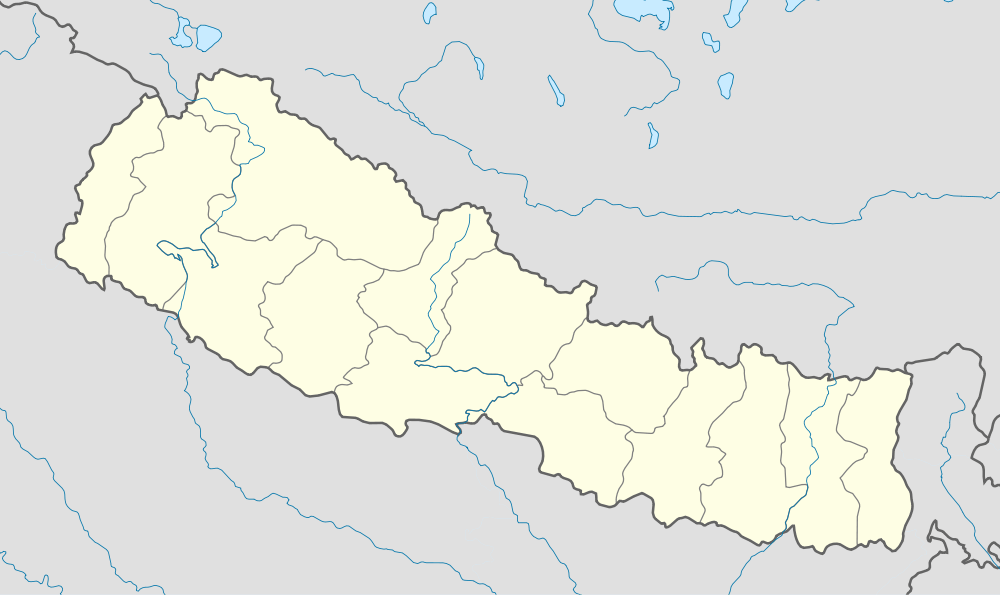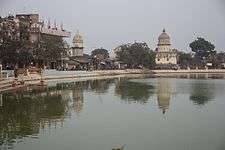Janaki Mandir
| Janaki Mandir | |
|---|---|
|
Abode temple of Maithali people | |
 Janaki Mandir Location in Nepal | |
| Name | |
| Other names | Nau Lakha Mandir |
| Proper name | Janaki Mandir |
| Geography | |
| Coordinates | 26°43′50″N 85°55′32″E / 26.73056°N 85.92556°ECoordinates: 26°43′50″N 85°55′32″E / 26.73056°N 85.92556°E |
| Country | Nepal |
| District | Dhanusa District |
| Locale | Janakpurdham |
| Elevation | 78 m (256 ft) |
| Culture | |
| Primary deity | Sita (Janaki), Rama |
| Important festivals | Vivaha Panchami, Rama Navami, Dashain, Tihar-Deepawali and Chhath |
| Architecture | |
| Architectural styles | Russian architect. (Hindu-Rajput Style) |
| Number of temples | 70 |
| Number of monuments | 27 |
| History and governance | |
| Date built | 1967 B.S (1910 AD) |
| Website | Janakitemple.gov.np |
Janaki Mandir (Nepali: जानकी मन्दिर) is a Hindu temple of Janakpur in Mithila region of Nepal, dedicated to the Hindu goddess Sita.[1] It is the primary temple of Maithali native indigenous to Nepal. It is an example of 'Hindu-Rajput' Nepali architecture. It is often considered the most important model of Rajput architecture in Nepal. Fully built in bright white and constructed in an area of 4,860 sq. feet in a mixed style of Islamic and Rajput domes, the temple is 50 meters high. It is a three-storied structure made entirely of stone and marble. All its 60 rooms are decorated with the flag of Nepal, colored glass, engravings and paintings, with beautiful lattice windows and turrets. According to legends and epics, King Janak ruled this area (called Videha) during the Ramayana period. His daughter Janaki (Sita), during her swyambar, had chosen Lord Rama as her husband, and become queen of Ayodhya. There marriage ceremony had occurred in the nearby Temple.
| Temple on 2 Rupee (1996). | |
|---|---|
 | |
| Obverse: "Birendra Bir Bikram Shah Dev" and year (in Nepal Sambat). | Reverse: Janaki Mandir, face value and country name. |
History
The temple is popularly known as the Nau Lakha Mandir (meaning Nine Lakhs). The cost for the construction of the temple was about the same amount of money: Rupees Nine Lakhs or Nine Hundred Thousands and hence the name. Queen Vrisha Bhanu – of Tikamgarh, India built the temple in 1910 AD. In 1657, a golden statue of the Goddess Sita was found at the very spot, and Sita is said to have lived there. The legend said it that it was built on the holy site where Sannyasi Shurkishordas had found the images of Goddess Sita. In fact, Shurkishordas was the founder of modern Janakpur and the great saint and poet who preached about the Sita Upasana (also called Sita Upanishad) philosophy. Legend has claimed it that King Janak(Seeradhwaj) performed the worship of Shiva-Dhanus on this site.
As of 26 April 2015 the temple is reported to have partly collapsed from the earthquake in April 2015.[2]
Pilgrimage
Every year, thousands of pilgrims from Nepal, India, Sri Lanka and other countries visit Ram Janaki Temple to worship Lord Ram and Sita. During the festivals of Ram Nawami, Vivaha Panchami, Dashain and Tihar, there is presence of even more worshipers.
Photographs
-
.jpg)
Front view (Oct. 14, 2007)
-
Sunset view (Nov. 02, 2012).
-
early morning view (Nov. 02, 2012)
-
Inside view of Janki Mandir.
-

-

Historical Museum
.jpg)
See also
References
- ↑ http://janakpurdham.com/janaki-temple/
- ↑ "Nepal Earthquake Takes Heavy Toll on Temples". NDTV. 26 April 2015. Retrieved 3 May 2015.
External links
- Sita Upanishad
- Janaki Mandir on Google Maps
.jpg)
